Discover 11 hidden attractions, cool sights, and unusual things to do in New Albany (United States). Don't miss out on these must-see attractions: New Albany National Cemetery, Culbertson Mansion State Historic Site, and Carnegie Center for Art & History. Also, be sure to include Scribner House in your itinerary.
Below, you can find the list of the most amazing places you should visit in New Albany (Indiana).
Table of Contents
New Albany National Cemetery

Cemetery. New Albany National Cemetery is a United States National Cemetery located in the city of New Albany, in Floyd County, Indiana. Administered by the United States Department of Veterans Affairs, it encompasses 5.5 acres, and as of the end of 2005, had 6,881 interments. It is managed by Zachary Taylor National Cemetery.[1]
Address: 1943 Ekin Ave, 47150 New Albany (New Albany)
Culbertson Mansion State Historic Site
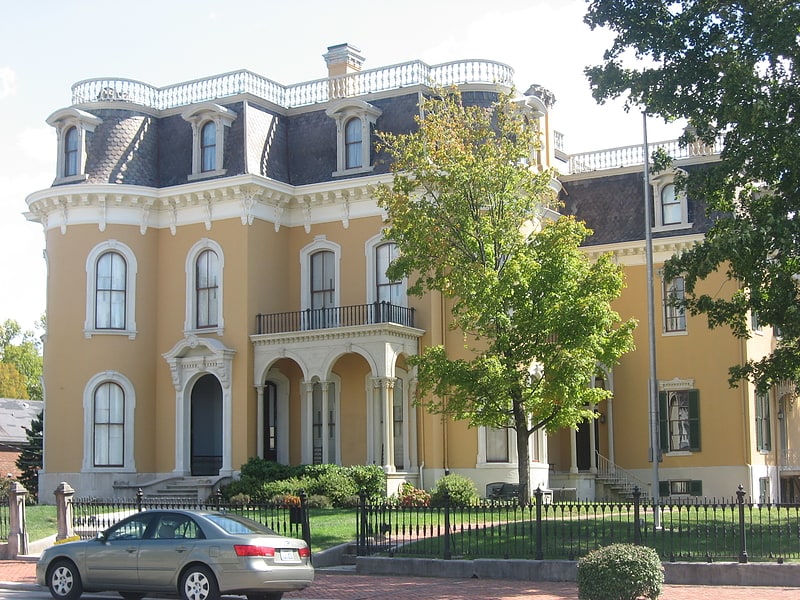
Edifice in New Albany, Indiana. Culbertson Mansion State Historic Site is located in New Albany, Indiana by the Ohio River. It was the home of William Culbertson, who was once the richest man in Indiana. Built in 1867 at a cost of $120,000, this Second Empire-style mansion has 25-rooms within 20,000 square feet, and was completed in November 1869. It was designed by James T. Banes, a local architect. Features within the three-story edifice include hand-painted ceilings and walls, frescoed ceilings, carved rosewood-grained staircase, marble fireplaces, wallpaper of fabric-quality, and crystal chandeliers. The original tin roof was imported from Scotland. The displays within the mansion feature the Culbertson family and the restoration of the building. The rooms on the tour are the formal parlors, dining rooms, bedrooms, kitchen, and laundry room.
In its heyday, a railroad ran behind the house (Culbertson had sold land to the railroad), and a streetcar ran from his house towards downtown New Albany.[2]
Address: 914 E Main St, 47150-5841 New Albany (New Albany)
Carnegie Center for Art & History

The Carnegie Center for Art & History, within the Downtown Historic District of New Albany, Indiana, is a contemporary art gallery and local history museum. The building was initially built as a Carnegie Library, first opened on March 2, 1904, with 11,125 total books. It is of Beaux-Arts architecture style. It was used as a library until 1969, when the new New Albany-Floyd County Public Library was built. After a $1.2 million renovation in 1998, the name was changed to the Carnegie Center for Art & History to better reflect its mission and library heritage. In 2015, total attendance was 26,690 and Carnegie Center staff presented 107 programs to participants of all ages. The Carnegie Center has a full-time staff of four employees, which includes a Director, Curator, Coordinator of Public Programming and Outreach and First Impression Receptionist and a part-time maintenance person. Three part-time trained volunteers come in weekly to manage a collection of over 5,000 objects. All exhibits and programs are offered free of charge to the public.
In addition to changing exhibits of contemporary art, the Carnegie Center has two permanent exhibitions. The first is entitled "Ordinary People, Extraordinary Courage: Men and Women of the Underground Railroad," which includes an interactive multimedia program. The exhibit's brochure states: "This unique exhibit draws the national phenomenon of the Underground Railroad into sharp focus by revealing the contributions of ordinary people from New Albany and Southern Indiana, whose courageous acts helped overthrow the institution of slavery." The second permanent exhibit is entitled "Remembered: The Life of Lucy Higgs Nichols".[3]
Address: 201 E Spring St, 47150-3422 New Albany (New Albany)
Scribner House
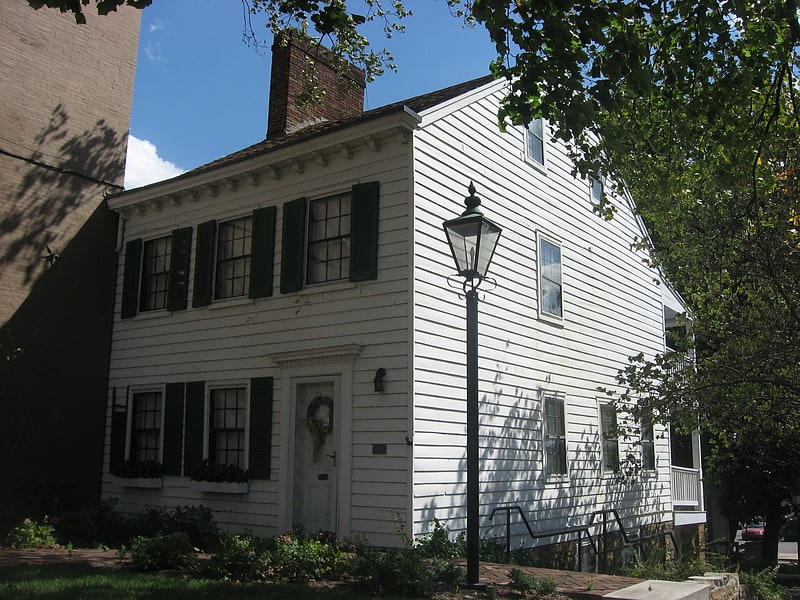
Building in New Albany, Indiana. The Scribner House is a historic home located at New Albany, Floyd County, Indiana. It was built by Joel Scribner, one of the three brothers who founded New Albany. He and his brothers, Nathaniel and Abner, came from New York State and named their new town "New Albany" after the capital of their home state. It is located in downtown New Albany, on the southeast corner of State and Main Streets near the Sherman Minton Bridge. It is the oldest building in New Albany.
Joel built the house in 1813-1814 using the ash, oak, and poplar trees that were cut down when clearing the property. It is designed in a New England Federal style. In total, it is 21⁄2 stories. The first floor features two parlors and a hall. The second floor has 3 bedrooms. Both these floors have a rear porch that allowed a view of the Ohio River. The ground floor is the large kitchen with a wide fireplace used for cooking.
The house passed through the family until the final owner, Harriet Scribner, a member of the Daughters of the American Revolution, sold it to the Piankeshaw Chapter of the National Society Daughters of the American Revolution, who made sure to keep it as Harriet left it when she died later that year. In 1977 it was put on the National Register of Historic Places.
Twice a year open house events are held, the third Saturday in May and the first Sunday in December. The December open house includes a Victorian tea Other tours can be made by appointment. All third grade children in Floyd County also visit Scribner House during the school year.[4]
Mansion Row Historic District
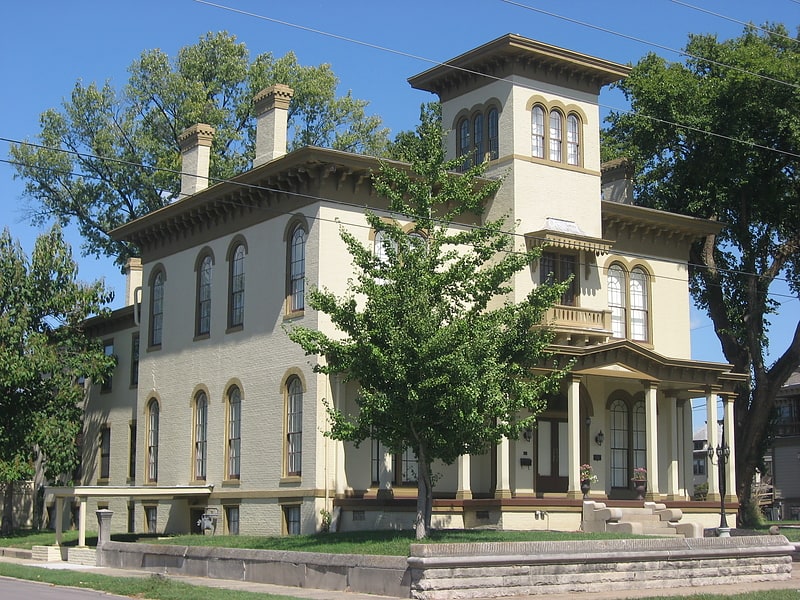
Historical place in New Albany, Indiana. The Mansion Row Historic District is a national historic district located at New Albany, Indiana. It features some of the various mansions of the city when New Albany was the largest city in Indiana around the time of the American Civil War. The main section is on Main Street from State Street, to 15th Street. A smaller section is on Market Street from E. 7th Street to E. 11th Street.
Most of the buildings are of the Federal and Italianate styles, but other styles of the mansions are of Greek Revival, Gothic Revival, and Victorian. Most of the oldest of the buildings are of the Federal style, built before Upper High Street was renamed East Main Street.
It was listed on the National Register of Historic Places in 1983.[5]
William Young House
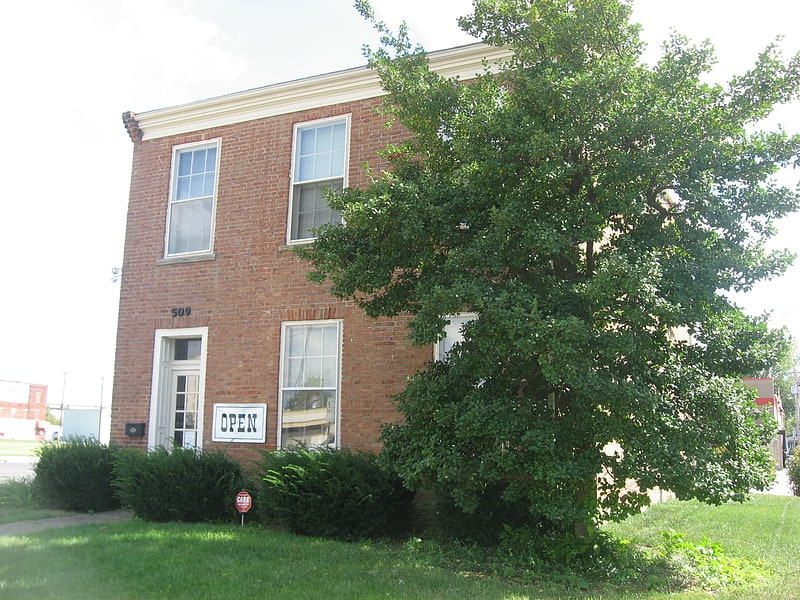
Museum in New Albany, Indiana. The William Young House is a historic home located at New Albany, Indiana. It was built about 1837, and is a two-story, three bay, Federal style brick I-house. It features a two-story porch alongside the rear ell. Much of the interior remains intact. The house is open as a museum.
It was listed on the National Register of Historic Places in 2010.[6]
Town Clock Church
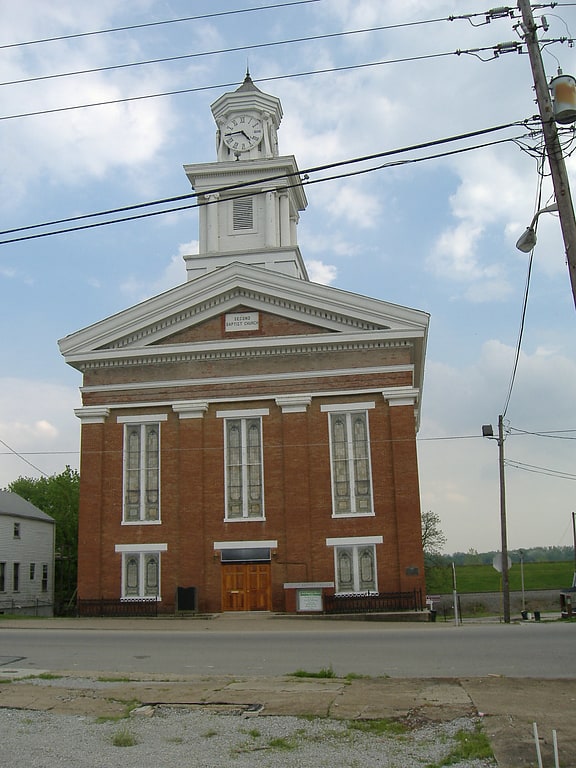
Religious institution in New Albany, Indiana. The Town Clock Church, now the Second Baptist Church of New Albany, Indiana, United States, is a historic church located at 300 East Main Street, within the New Albany Downtown Historic District. It was constructed in 1852 as Second Presbyterian Church, in what was then the largest city in Indiana. It is near the Ohio River, across the border from Louisville, Kentucky.
It was a station on the Underground Railroad.
The church is brick, and is constructed in the Greek Revival style of architecture. It previously had a 160-foot high clock tower that could be seen by boat crews on the Ohio River. However, the tower has been shortened. The first phase of reconstruction is underway which will include a new steeple and clock faces. When reconstruction is complete, the tower will once again be 160 feet tall.[7]
Old Pike Inn
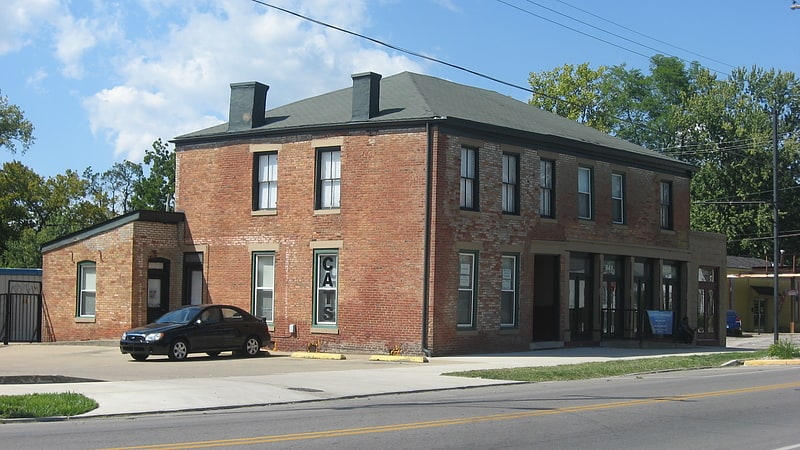
Inn in New Albany, Indiana. The Old Pike Inn is a historic inn and tavern located at New Albany, Floyd County, Indiana. It was built about 1840, and is a two-story brick building with a hipped roof. The building was damaged in a tornado on March 23, 1917, and the building rebuilt. It remained a working tavern until 1997, when the owner decided to shut down and start working for Caesars Indiana.
It was listed on the National Register of Historic Places in 2001.[8]
Woodbine
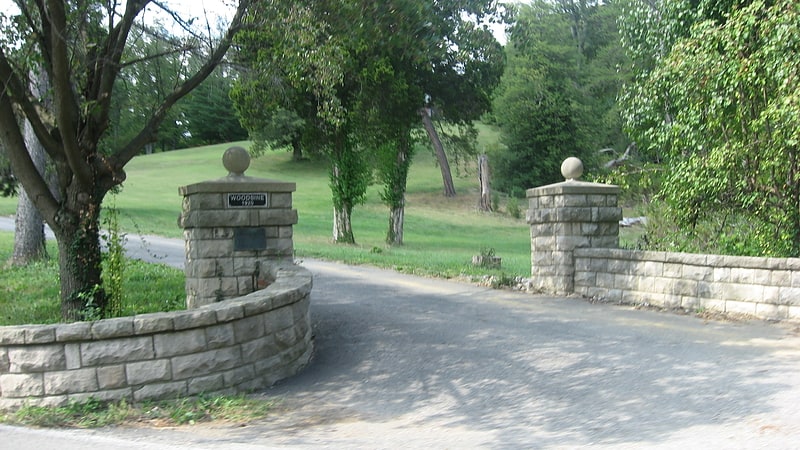
Woodbine, also known as the Anders Rasmussen House, is a historic early-20th-century estate located at New Albany, Floyd County, Indiana. It was built in 1920 for Anders Rasmussen, who owned a florist business in New Albany and once served as a florist for the King of Denmark. The 2+1⁄2-story Bungalow / American Craftsman-style house is made of stucco, brick, limestone, asphalt, and terra cotta, with a full basement. The house includes a 1+1⁄2-story caretaker's apartment. The house stayed with the family until 1945, and has gone through several hands since then. The estate is currently owed and being restored by the owner/winemaker for Downtown New Albany's River City Winery located just two miles away. Plans for a vineyard on the estate are underway.
It was listed on the National Register of Historic Places in 1994.[9]
Division Street School

Building in New Albany, Indiana. The Division Street School is a historic school building located at New Albany, Floyd County, Indiana. It was one of the first elementary schools for African-American children, with construction beginning in June 1884, and the opening in 1885. It was moved by thirty feet westward in 1922. It was untouched by the Ohio River flood of 1937. It operated as a school until May 1946, while segregation still took place; those students still attended were assigned to Griffin Street School. From 1946 until 1948 it was a Veterans Administration Office. It was then used as a maintenance shop for the New Albany/Floyd County School Corporation until 1999. After restoration, it is now used for various community activities.
It was listed on the National Register of Historic Places in 2002.[10]
East Spring Street Historic District
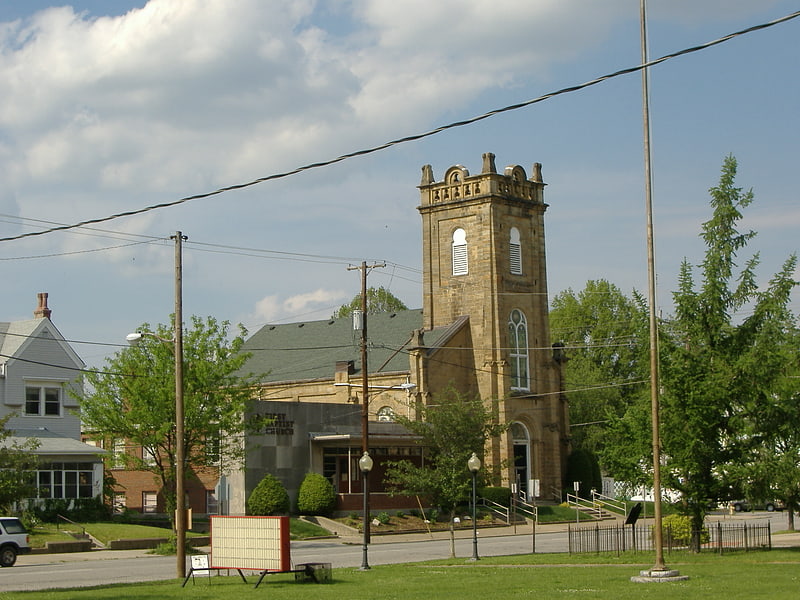
The East Spring Street Historic District is a national historic district located at New Albany, Indiana. The general area is E. Fifth Street to the west, Spring St. to the north, E. Eighth Street to the east, and Market Street to the south. The Cedar Bough Place Historic District is one block north of the area, the New Albany Downtown Historic District is immediately west of the area, and the Market Street section of the Mansion Row Historic District starts. The district encompasses 84 contributing buildings in a largely residential section of New Albany. It developed in the late-19th and early-20th century and includes notable examples of Queen Anne and Italianate style architecture. Notable buildings include the Third Presbyterian Church, St. Mary's Roman Catholic Church and Rectory, the former John Conner House or Masonic Lodge, and Edwards City Hospital.
It was listed on the National Register of Historic Places in 2001, with a boundary increase in 2020.
In its prime, it was a haven for those of middle-class and upper-class social status. Many churches are within the area.[11]